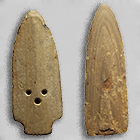Japanese Archaeology and Special Exhibition (Heiseikan) Japanese Archaeology Gallery
October 29, 2013 (Tue) - March 9, 2014 (Sun)
Rice cultivation culture entered the Japanese archipelago in northwestern Kyushu, along the Genkai Sea coast. Many bronze wares from mainland Asia spread through this area. Meanwhile, from a northeastern coastal area of Kyushu known as Hibikinada, to the Sea of Japan side of Yamaguchi prefecture (western end of Honshu), many early-Yayoi period sites and settlements were created. Among these sites, objects such as geometric mirrors and handled bronze daggers have been excavated from the Shimonoseki area. This area is regarded as the easternmost edge of the primary distribution region of bronze wares that came from the Korean peninsula.
Excavations at the Ayaragigo archaeological site, which is famous for a number of large storage pits shaped like pouches, have discovered various earthenware vessels, stone implements, accessories and food-related items. This site is an excellent example of a farming community from the early Yayoi to mid-Yayoi period.
Ayaragigo-style earthenware vessels spread from the coastal region of Hibikinada to the San'in region and the western part of the Seto Inland Sea. The vessels feature wide shoulders and beautiful designs created using shells, including arrowhead patterns and feather-like motifs. Other excavated objects include religious items and magatama beads similar to beads from the Korean peninsula's Bronze Age, as well as earthenware bowl flutes, which characterize early Yayoi-period culture on the Sea of Japan coast. These objects mark the route of rice-cultivation and farming culture, which originated on the Asian mainland, as it spread eastward through Honshu, as well as how the Ayaragigo site was a focus of cultural exchange.
This exhibition, part of the museum's exchange program of archaeological objects in 2013, introduces distinctive Yayoi culture from the westernmost area of Honshu, through excavated items from the Shimonoseki City Archaeological Museum collection.

